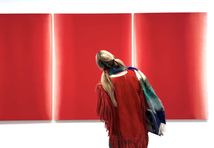Robert Rauschenberg
- The Courtauldian
- Feb 20, 2017
- 4 min read

Robert Rauschenberg - Catalogue Review
Although Rauschenberg has a strong advocate across the pond in the Museum of Modern Art (New York), his work has experienced somewhat patchy coverage here in the UK. The spark that should have lit the fire was an exhibition at the Whitechapel Gallery in 1964. In 1981, the Tate Gallery, as it was then known, held another in-depth exhibition of his work; but it was to be the last one of any substance for thirty-six years. The recent collaboration between MoMA and Tate to bring Rauschenberg to Tate Modern therefore represents something of a long-overdue opportunity, both to represent the artist in the full breadth of his sixty-year career, but also to expand the ways in which we approach the presentation of art history itself. In Robert Rauschenberg, this mission is extended beyond the walls of Tate Modern onto the printed page.
Described as the ‘first comprehensive catalogue’ of Rauschenberg’s career in twenty years, it would be hard to argue with the claim for its expanse. Not only are the expected paintings, combines, and silk screens well represented but archival material is abundant. Documentary photographs of the candid kind also show the artist in action. The generous space afforded to his work on the page is entirely necessary – they’re complex and confusing, involving layers and textural coatings, deposits and protrusions. Happily, Rauschenberg’s lithograph Autobiography (1968) is given a luxurious fold out double spread, and sits easily amongst the documentary photographs.
The catalogue begins and ends with two essays entitled ‘Five Propositions’ that essentially bookend the discussions around Rauschenberg’s practice. Highlighting the joint endeavour between Tate and MoMA; the one end, Achim Borchardt-Hume, Tate Modern’s Director of Exhibitions, focuses on ‘Availability’, ‘Collaboration’, ‘Movement’, ‘Time’ and ‘Travel’; at the other, MoMA’s Marlene Hess Curator of Painting and Sculpture, Leah Dickerman looks at ‘The Destruction of Painting’, ‘Collage in the Expanded Field’, ‘Radical Equivalence’, ‘Cooperative Art’ and ‘Technology’. These subtitles act as points of reference throughout the catalogue, taking the discussion of Rauschenberg’s art into places that are not always on the whistle-stop tour of his legacy.
Ed Krčma explores how, between 1958-60, Rauschenberg addressed the classical tradition and yet also subverted the existing models of creating art. Using a method of transferring the ink from clippings of newsprint and magazines, Rauschenberg incorporated images from the media into drawings that he made to accompany Dante’s Inferno. Krčma compellingly argues that Rauschenberg set up a potentially symbolist dialogue between contemporary American culture and the stories, motifs and emblems that he was ‘raiding’ from the classical tradition. You can hear more from Ed Krčma as he’ll be talking about Rauschenberg’s drawings for Dante’s Inferno at the Courtauld Institute Research Forum event on 27th February (more info here).

Peter Moore. Photograph of Robert Rauschenberg’s Pelican (1963) as performed in a former CBS television studio, New York, during the First New York Theater Rally, May 1965.
Particularly interesting contributions come from Hiroko Ikegami and Catherine Wood. Ikegami explores the impact of Rauschenberg’s attempt to ‘introduce the world to itself though his art’. On a trip to China in 1982 to work at the Xuan paper mill in Jingxian, Anhui Province, Rauschenberg was shocked by the experience of the Chinese people he spoke to; one man had not seen his family in years due to arbitrary travel restrictions. Ikegami looks at the Rauschenberg Overseas Culture Interchange (ROCI), a project that seems to have anticipated the globalized art world and the ‘socially engaged or community-based art’ we are now familiar with. The varying reactions to ROCI are sensitively considered and culminate with Ikegami considering the implications and cadences with developing trends of mobility in art and an increasing expansion of diversity and globalization of the late 1980s. Indeed, the catalogue as a whole does not shy away from dealing with the aspects of Rauschenberg’s career that might have made the exhibition unwieldy or incoherent. ‘Force of Contact’ by Catherine Wood, Tate’s Senior Curator of International Art (Performance) looks at how Rauschenberg reinvented the way in which he used objects, especially through his interest in performance, to investigate how the inanimate can relate to lived experience and how it can have an active rather than passive role in art and life.
Just as Rauschenberg’s own output was immense, so too is the exhibition catalogue. Through exploring the various confluences and tributaries that exist within his work, here we see Rauschenberg’s breadth outside of the oft quoted snippets of his oeuvre. This isn’t a casual overview or rehash of the exhibition on the page – Robert Rauschenberg provides a thoroughly enriched understanding of the artist’s productive creativity.
Robert Rauschenberg, Tate Publishing, 2016, ISBN 978-1-84976-272-4
Note: The catalogue was provided for review by Museum Bookstore. Museum Bookstore offers a huge range of exhibition catalogues, past and present. They offer personalised shopping services for that particularly hard to find book or if you just need some inspiration for a special gift.












Comments